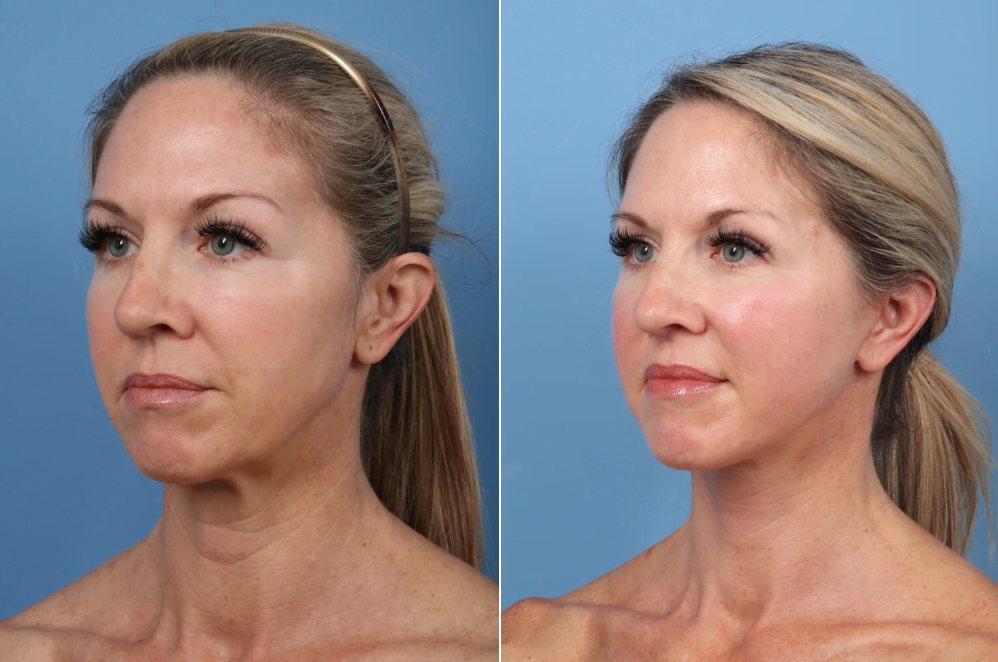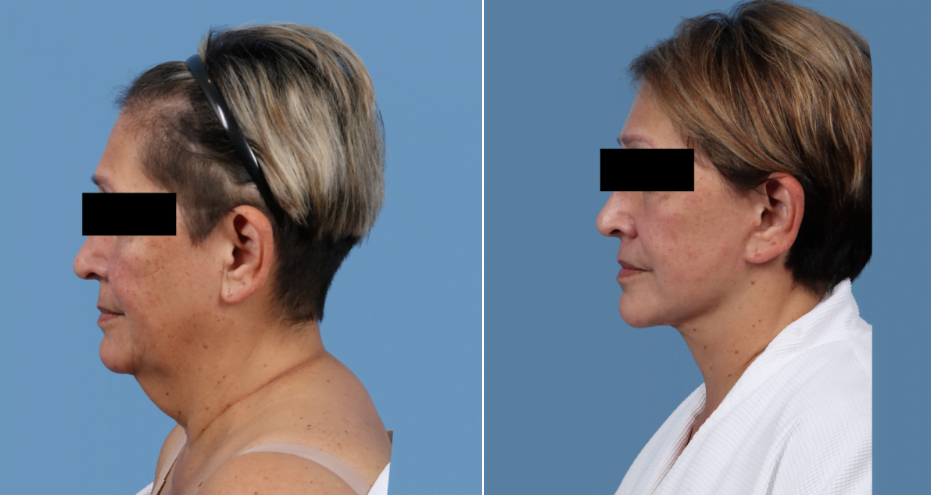From the SMAS facelift to the ponytail facelift to the vertical facelift, with all of the “specialized” facelift procedures that have unique names or are named after the surgeon, it can be hard to keep up. But if you only remember one facelift technique, make it this one: the deep plane face and neck lift. Below, Houston plastic surgeon Dr. Bob Basu explains why this is his preferred technique for lasting results that address jowling and other signs of aging to restore a distinct, natural-looking midface and jawline.
Facelift techniques: Skin lift vs. deep plane facelift
Skin lift
The most superficial facelift technique, a skin lift tightens loose skin without affecting the muscles or connective tissues underneath.
A skin lift is relatively easy to perform for most surgeons. However, the problem with this technique is that, as we age, our skin loses elasticity and tone. Without actually changing the quality of the skin, it can “relax” again and lead to a recurrence of laxity, or looseness.
Further, skin lifts can create that overly tight, artificial, or “windswept” appearance characteristic of a poor facelift. (A creased, horizontal line at the corner of the mouth is another telltale sign of too much surgery or “overdone” results.) The best facelift results, on the other hand, are the results that look simply refreshed, but the skin retains a natural-looking amount of tension.
Although a skin lift is simpler for a surgeon to perform (and potentially will cost less), facelifts that rely on skin lifting alone are simply not ideal in terms of the appearance or longevity of your results. While many people think that skin tightening is all that a facelift is, in fact, a well-done facelift involves much more—more on that below.
Deep plane facelift: Dr. Basu’s preferred technique
The lifting power of the deep plane face and neck lift does not come from skin tightening—it actually comes from tightening the strength layer (superficial musculoaponeurotic system, or SMAS) of the face, without disconnecting it from the skin.
During a deep plane facelift, the connecting ligaments below the strength layer are disconnected, allowing your surgeon to lift the SMAS and the skin together as a composite unit. In short, this technique actually tightens the deeper layer, and the skin is lifted along with it. All the work is done with the deeper strength layer of the face to facilitate longer-lasting and better results.
As one of my happy deep plane face and neck lift patients described it to me, in the deep plane technique, all the work is done on the foundation layer of the face and neck.
The deep plane technique far out-performs other facelift techniques, establishing a strong foundation for lifted skin and creating natural-looking jawline definition.
This powerful technique gives you a much more refreshed result without an “over-tight” look. It can give you a sharper jawline, eliminate the jowls, and give you a very toned neck appearance, which is a high priority for all of our face and neck lift patients.
The deep plane facelift technique also reduces tension on incisions, so your facelift incision lines will heal better and faster, and result in finer scars that disappear more quickly.
What’s the right age for a deep plane facelift?
There’s no right or wrong age for a facelift: if you’re concerned about jowling, loose skin, signs of aging in your neck, and the appearance of your cheeks and midface, then you might be a good candidate for a deep plane face and neck lift. This technique produces the most natural-looking and long-lasting results, and each facelift is fully customized based on the patient’s concerns and anatomy.

Where are incisions and scars from a deep plane facelift?
Typically, the incision is placed on the front portion of the ear along the natural groove, inside the ear canal, out underneath the ear lobule, and then behind the ear.
However, Dr. Basu’s technique can vary depending on how much sagging you need to correct. If you have more severe laxity, you may require an extended incision in your posterior hairline.
While facelift scars can sound intimidating, the portion of the scar that is visible after surgery is quite small: when patients come back to our office for follow-up visits, most are only aware of an approximately one-centimeter long segment of the scar at the top of their ear, in front of their ear groove, and possibly a one centimeter segment in front of their ear lobe. Given proper scar care, these will heal in time to become invisible without close examination.
What if I only want a neck lift?
It is always an option to have an isolated neck lift, only treating below the jaw line/underneath your chin, without a lower facelift. In this operation, the incision is a small, two-centimeter line placed underneath the chin (sometimes with an additional incision behind the ear).
If you are already planning to undergo anesthesia for a neck lift, it only adds about an hour to include the jawline and cheeks for a full face and neck lift.
However, Dr. Basu always advises patients that, if you are already planning to undergo anesthesia for a neck lift, it only adds about one hour to the surgery to include the jawline and cheeks for a full face and neck lift. They are typically performed together, and this pair usually leads to the best possible results.
What’s the best facelift alternative?
We recently saw a patient in her mid-forties who maintains a busy schedule and did not have the time for a surgical facelift recovery. We introduced her to alternative options and she opted for minimally-invasive FaceTite paired with Morpheus8 microneedling to boost collagen and increase firmness in her skin. These procedures, along with adherence to monthly HydraFacials and a prescription-strength skincare regimen, can delay the need for a face and neck lift by 5 to 10 years.
How long does a deep plane facelift take?
Deep plane face and neck lift surgery typically takes between 3 and 4 hours, depending on the extent of tightening and lifting needed in the neck. A facelift can be safely and comfortably performed as outpatient surgery, which means that you can go home with a responsible adult the day of surgery.
You may have a longer operative time if you choose to combine face and neck lift surgery with other surgeries. Other common procedures include a temporal brow lift, a surgical lip lift, and/or fat transfer to the cheeks or other areas.
What part of the face does a face and neck lift treat?
A face and neck lift targets the area from the ears, to jawline and chin, and neck, down to just above the collarbone.
A facelift does not specifically treat the lips, cheeks, upper and lower eyelids, or brow position, so patients often choose to combine this surgery with a brow lift, lip lift, or eyelid lift for a holistic approach.

How long do deep plane facelift results last?
Typically, results last anywhere from 5 to 15 years. However, regular skin treatments such as HydraFacials or Morpheus8 radiofrequency microneedling can extend the results. Your home skincare routine, UV protection, nutrition, and hydration can also promote the longevity of a facelift.
A healthy lifestyle, skincare, and treatments like injectables and lasers will make a notable difference when it comes to refining and maintaining facelift results.
Surgical and non-surgical treatments working together
The deep plane facelift is a sophisticated tool for reversing facial sagging, but we feel that true facial rejuvenation requires multiple modalities. To get a natural-looking, refreshed appearance that will last for years, we advise our patients to use a combination of surgical and non-surgical treatments, which often includes Botox & fillers to enhance and maintain surgical results, along with physician-grade skincare to improve the overall quality, texture, and tone of your skin.
About board-certified plastic surgeon Dr. Bob Basu in Houston
As one of America’s Best Plastic Surgeons according to Newsweek magazine, board-certified plastic surgeon Dr. Bob Basu has the experience to provide natural-looking surgical outcomes with modern techniques. To schedule your consultation and receive personalized facelift advice, call 713.799.2278 or contact us online today! Dr. Basu sees patients at two convenient office locations in Houston’s Galleria/Uptown neighborhood and in Cypress.

Leave a Reply